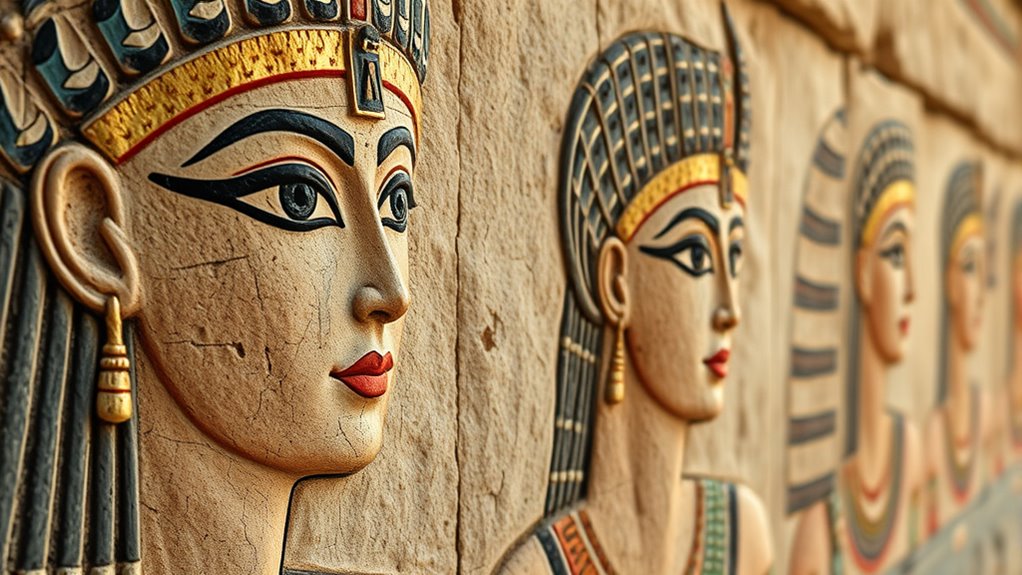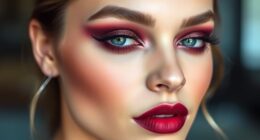Eyeliner has a rich history starting in ancient Egypt, where it symbolized protection, status, and spirituality, made from natural minerals like kohl and malachite. Over time, civilizations like Greece, Rome, and during the Renaissance refined its use to express identity and social standing. In the 20th century, bold styles emerged, reflecting cultural shifts. Today, eyeliner is a powerful tool for self-expression and cultural storytelling. Exploring this journey reveals how makeup connects history, identity, and artistry—there’s much more to uncover.
Key Takeaways
- Eyeliner originated in ancient Egypt, where it was used for protection, spiritual symbolism, and social status.
- The Egyptians crafted eyeliner from natural minerals like malachite and kohl, emphasizing durability and vibrant colors.
- Throughout history, eyeliner styles evolved through Greece, Rome, Middle Ages, and Renaissance, reflecting cultural beliefs and societal norms.
- The 20th century saw innovations in formulations and styles, from bold flapper looks to graphic and colorful designs of modern eras.
- Today, eyeliner is a versatile tool for self-expression, cultural identity, and artistic creativity, with contemporary trends emphasizing bold, geometric shapes.
The Origins of Eyeliner in Ancient Civilizations

Have you ever wondered where eyeliner first appeared? Ancient civilizations used this cosmetic not just to enhance appearance but also for its ritual significance. In ancient Egypt, eyeliner was an essential part of daily life, crafted from natural ingredients like malachite and kohl. It served more than aesthetic purposes; it was believed to protect the eyes from evil spirits and harmful sun rays.
Egyptians viewed eyeliner as an ancient cosmetic that held spiritual importance, often linked to divine protection and status. Similarly, in Mesopotamia and the Indus Valley, people used dark pigments around their eyes for ceremonial reasons. These early cultures recognized eyeliner’s power to symbolize identity, spirituality, and social standing, laying the foundation for its evolving role in beauty and ritual.
Symbolism and Spirituality in Early Eyeliner Use

In ancient times, the use of eyeliner extended beyond mere decoration to embody deep spiritual and symbolic meanings. You might’ve worn it not just to enhance beauty but to connect with spiritual symbolism and ritual significance.
Eyeliner often signified protection from evil spirits or misfortune. It also served as a marker of social or religious status, emphasizing your identity within a community. The cultural significance of eyeliner reinforced its role as a powerful cultural marker.
In some cultures, the bold lines represented divine power or connection to the gods. These symbols reinforced your spiritual beliefs and your place in society, making eyeliner a tool for more than aesthetics. Additionally, the ritual application of eyeliner was often performed with specific gestures or prayers, heightening its spiritual importance. The historical evolution of eyeliner usage highlights its transition from sacred ritual to modern fashion statement.
The ritual significance of applying eyeliner was often a sacred act, imbued with meaning beyond appearance. This spiritual symbolism transformed eyeliner into a meaningful cultural practice, emphasizing the cultural importance of personal adornment in ancient societies.
The Influence of Egyptian Culture and Art
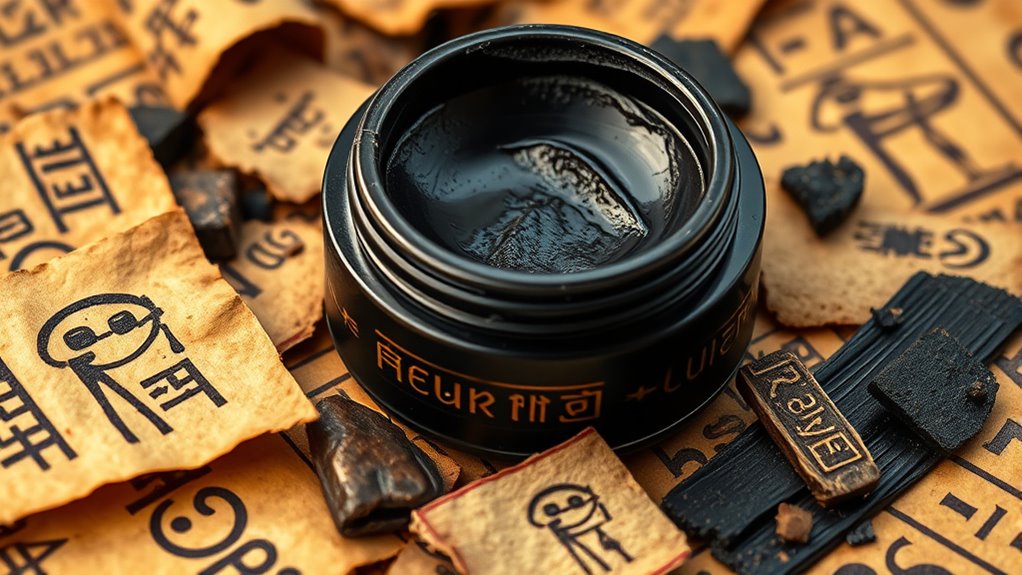
Egyptian culture and art profoundly shaped the history of eyeliner, elevating it from simple cosmetic to a symbol of status, spirituality, and identity. Ancient cosmetics like kohl were carefully crafted using natural minerals, reflecting the Egyptians’ mastery of beauty and symbolism.
Eyeliner wasn’t just about enhancing appearance; it carried deep Egyptian symbolism, representing protection, power, and divine connection. The iconic eye designs, seen in tomb paintings and sculptures, emphasized the importance of spirituality and the divine right of pharaohs. Furthermore, the symbolic significance of eyeliner in Egyptian culture underscored its role beyond aesthetics, linking it to religious practices and social hierarchy. This use of cosmetic symbolism helped solidify eyeliner as a cultural artifact, rather than merely a beauty product.
The Egyptians also employed specific application techniques to ensure the durability and spiritual meaning of their eyeliner designs, which contributed to their lasting influence. They developed specialized tools and methods to apply eyeliner with precision, ensuring that the designs maintained their visual impact over time. By incorporating these elements, Egyptians transformed eyeliner into more than a beauty trend. Instead, it became an essential part of their cultural identity, linking the physical with the spiritual and emphasizing social hierarchy. Optimal Angles for Pinball Machines can also influence how these symbolic designs were applied, ensuring they held their intended meaning and visual impact.
This influence set the stage for eyeliner’s significance throughout history.
Eyeliner in Ancient Greece and Rome

As the influence of Egyptian culture waned, the practice of using eyeliner persisted and evolved in ancient Greece and Rome, reflecting their unique ideas of beauty and self-expression. They used ancient cosmetics like kohl and charcoal to define their eyes, often emphasizing mythical symbolism, such as invoking protection or divine favor. The Greeks and Romans also believed that darkened eyes could ward off evil spirits, blending beauty with superstition. Additionally, these civilizations adopted cosmetic application techniques that enhanced their features and conveyed social status. The use of eyeliner became a form of personal and cultural identity, blending practical beauty enhancements with symbolic meanings. The history of cosmetic materials shows how the ingredients and application methods evolved over time, influencing modern practices. Furthermore, they developed beauty rituals that incorporated eyeliner as an essential element, reflecting their cultural values. This evolution highlights how ancient cosmetics served both aesthetic and spiritual purposes, shaping the legacy of eyeliner across civilizations. Notably, the wealth of female singers today reflects how beauty and self-expression continue to be linked to status and cultural identity. Additionally, the development of application tools played a crucial role in refining the precision and style of eyeliner application throughout history.
The Evolution of Eyeliner Through the Middle Ages and Renaissance

During the Middle Ages, eyeliner fell out of favor as more modest beauty standards took hold, and makeup was often associated with vanity. However, during the Renaissance, bold eye enhancements made a comeback, reflecting changing ideals of beauty. You’ll see how these shifts influenced the way eyeliner was used and perceived across different eras. Additionally, the resurgence of elaborate fashion and cultural influences contributed to a renewed interest in expressive eye makeup, demonstrating how cultural trends can shape beauty practices over time. The use of cosmetic products also evolved as societal attitudes towards makeup became more accepting and experimental. This period also marked the beginning of a more creative approach to personal adornment, paving the way for modern makeup artistry. As techniques and products advanced, the development of cosmetic tools further facilitated innovative styles and expressions. Furthermore, the invention of new application techniques allowed for more precise and varied eyeliner styles, expanding creative possibilities for makeup artists and enthusiasts alike.
Medieval Eyeliner Practices
Medieval and Renaissance societies embraced eyeliner as a symbol of social status and beauty, often applying it with deliberate artistry. You’d notice that medieval cosmetics, including eyeliner, became more refined, reflecting societal hierarchies and personal identity. Eyeliner rituals were intricate, involving natural dyes made from minerals and plants, emphasizing both beauty and protection. During this period, the emphasis shifted from purely aesthetic to symbolic, with darkened eyes signifying power or spiritual significance. Automation in business technologies contributed to the development of cosmetics manufacturing processes, enhancing the consistency and durability of eyeliner products. Additionally, the refinement of pigmentation techniques allowed artisans to produce more vibrant and long-lasting colors, elevating the importance of eyeliner in societal and cultural contexts. The use of mineral pigments to create lasting, striking lines—the role of eyeliner in social rituals and status display—how eyeliner application reflected cultural beliefs and symbolism.
Renaissance Beauty Standards
The Renaissance marked a significant shift in beauty ideals, with emphasis placed on individuality and refined elegance. During this period, medieval cosmetics gave way to new notions of renaissance aesthetics, focusing on subtlety and sophistication.
Women and men used eyeliner more deliberately, often emphasizing the eyes to enhance their expressive qualities. Instead of the bold lines of medieval times, renaissance beauty standards favored softer, more natural looks, yet still highlighted the eyes’ allure.
Eyeliner techniques became more refined, using fine brushes or pencils to create precise lines. You’d observe a move away from heavy, dark contours, embracing a balanced elegance that celebrated personal style. This evolution reflected a broader cultural shift toward humanism and self-expression, shaping modern perceptions of beauty and makeup. Additionally, the use of cosmetic tools improved, allowing for more detailed and delicate application, which contributed to the sophisticated aesthetic of the era. Furthermore, the development of beauty standards during this time laid the groundwork for contemporary makeup artistry.
The Flapper Era and the Rise of Dramatic Looks in the 1920s
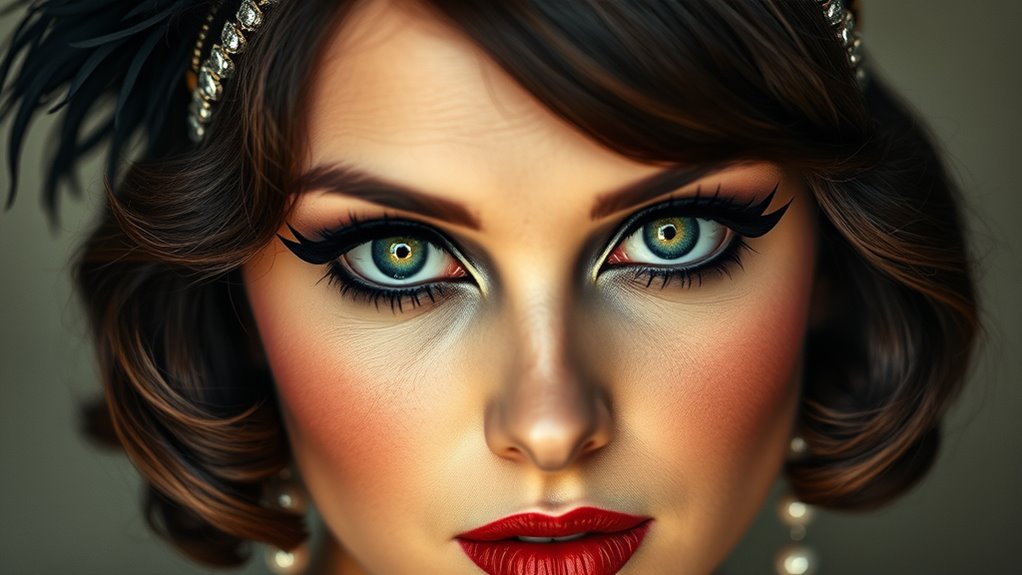
The 1920s marked a revolutionary shift in eyeliner styles, driven by the flamboyant flapper culture. You embrace bold, dramatic looks as part of the flapper fashion, emphasizing your eyes with dark, defined lines that extend beyond the natural lash line.
1920s makeup becomes a symbol of independence and rebellion, allowing you to express your individuality. The era’s eyeliner style reflects a desire to stand out, blending art and attitude.
- Flapper fashion encourages daring beauty choices, breaking traditional norms
- Eyeliner becomes a tool for self-expression and empowerment
- The dramatic look mirrors the era’s energetic, rebellious spirit
Innovations and Trends in the 20th Century

Throughout the 20th century, makeup innovations and evolving trends transformed eyeliner from a simple cosmetic into a dynamic form of self-expression. You witness how new eyeliner techniques emerged, making makeup application more creative and accessible.
The introduction of pencils, gels, and liquid liners allowed for precise lines and dramatic effects. During the 1960s and 70s, bold, graphic styles gained popularity, encouraging experimentation with winged or extended shapes.
Later, in the 1980s, vibrant colors and exaggerated styles became trendy, reflecting the era’s energetic vibe. Throughout these decades, innovations in formulation and application methods enabled you to achieve a variety of looks—from subtle definition to statement-making artistry—highlighting eyeliner’s evolution as a versatile tool in personal style and cultural expression.
The Rise of Bold and Graphic Styles in Contemporary Fashion

As makeup techniques became more creative and diverse in the 20th century, the focus shifted toward making a bold statement. Today, bold makeup and graphic eyeliner dominate contemporary fashion, allowing you to express individuality and challenge norms.
You might experiment with sharp lines, geometric shapes, or exaggerated strokes that demand attention. This style encourages you to break free from subtlety and embrace visual impact.
- Emphasizes personal identity beyond traditional beauty standards
- Reflects cultural influences and artistic innovation
- Inspires confidence through daring, unconventional looks
With graphic eyeliner, you transform your face into a canvas, making a powerful statement that’s impossible to ignore. Bold makeup becomes a form of self-expression, pushing the boundaries of beauty and creativity.
Eyeliner as a Personal and Cultural Statement Today
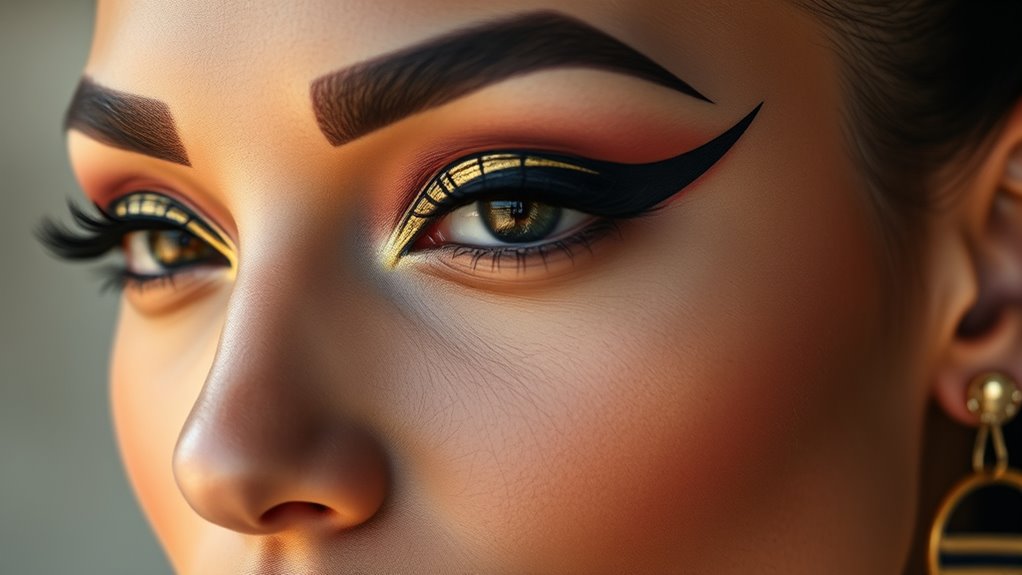
Eyeliner today serves as a powerful tool for expressing personal identity and cultural heritage. You can use different styles, colors, and techniques to showcase who you’re and what you stand for. Whether you prefer a subtle line or bold, artistic designs, eyeliner helps you communicate your personality without words.
It also reflects cultural identity, honoring traditions or making modern statements. For example, intricate designs inspired by Indigenous or Asian cultures connect you to your roots, while experimental looks highlight your creativity.
In today’s diverse society, eyeliner isn’t just makeup; it’s an empowering form of self-expression. It allows you to celebrate your individuality and cultural background, making every look uniquely yours.
Frequently Asked Questions
How Did Eyeliner Formulas Evolve Over Different Historical Periods?
You’ve seen eyeliner formulas evolve through cosmetic innovation, transforming from ancient kohl to modern pencil and gel options. Throughout history, formulas aimed for better application and formula preservation, leading to long-lasting, smudge-proof products.
Innovations like waterproof formulas and mineral-based options emerged, providing safer, more durable choices. Today, your options blend tradition with technology, making it easier than ever to achieve your desired look while enjoying improved formula preservation.
What Materials Were Traditionally Used to Make Ancient Eyeliners?
Imagine dipping a brush into a vibrant, ancient pigment to craft your look. Traditionally, ancient eyeliners used materials like malachite and kohl, which served as both cosmetic application and protection against the sun’s glare.
These natural substances, derived from minerals and plant extracts, allowed you to achieve bold, enduring lines. Their rich history still influences modern formulations, blending tradition with contemporary beauty practices seamlessly.
How Did Cultural Exchanges Influence Eyeliner Styles Across Civilizations?
Cultural influences and stylistic exchanges markedly shaped eyeliner styles across civilizations. When you explore different cultures, you’ll notice how ideas and techniques traveled through trade, conquest, and migration.
These exchanges introduced new materials, colors, and designs, blending traditional styles with innovative trends. As a result, eyeliner evolved uniquely in each society, reflecting their values and aesthetics, creating a rich tapestry of beauty practices influenced by cross-cultural interactions.
Are There Any Health Risks Associated With Historical Eyeliner Ingredients?
You might think ancient eyeliner was perfectly safe, but it wasn’t! Some ingredients contained toxic substances that could cause serious health risks, like cosmetic allergies or even poisoning.
Applying these cosmetics could’ve led to eye infections or allergic reactions that felt like a nightmare. Today’s safer formulas help you avoid those dangers, but it’s wild to think about how old beauty routines could have been so risky!
How Has the Societal Perception of Eyeliner Changed Over Time?
Societal perceptions of eyeliner have shifted profoundly, reflecting changing gender norms and beauty standards. You might notice that in the past, eyeliner was often associated with femininity, but today, it’s embraced by all genders, symbolizing individuality and self-expression.
As beauty standards evolve, so does the acceptance of eyeliner as a versatile accessory, allowing you to experiment freely without societal judgment, highlighting a broader move toward inclusivity and personal style.
Conclusion
Today, eyeliner can be bold or subtle, a personal choice reflecting culture and identity. While ancient Egyptians used it for spirituality, modern trends often focus on self-expression. You hold the power to connect history with your unique style, blending tradition with innovation. Just as eyeliner has evolved from sacred symbols to fashion statements, your look becomes a canvas—where history and individuality meet in a single stroke.
